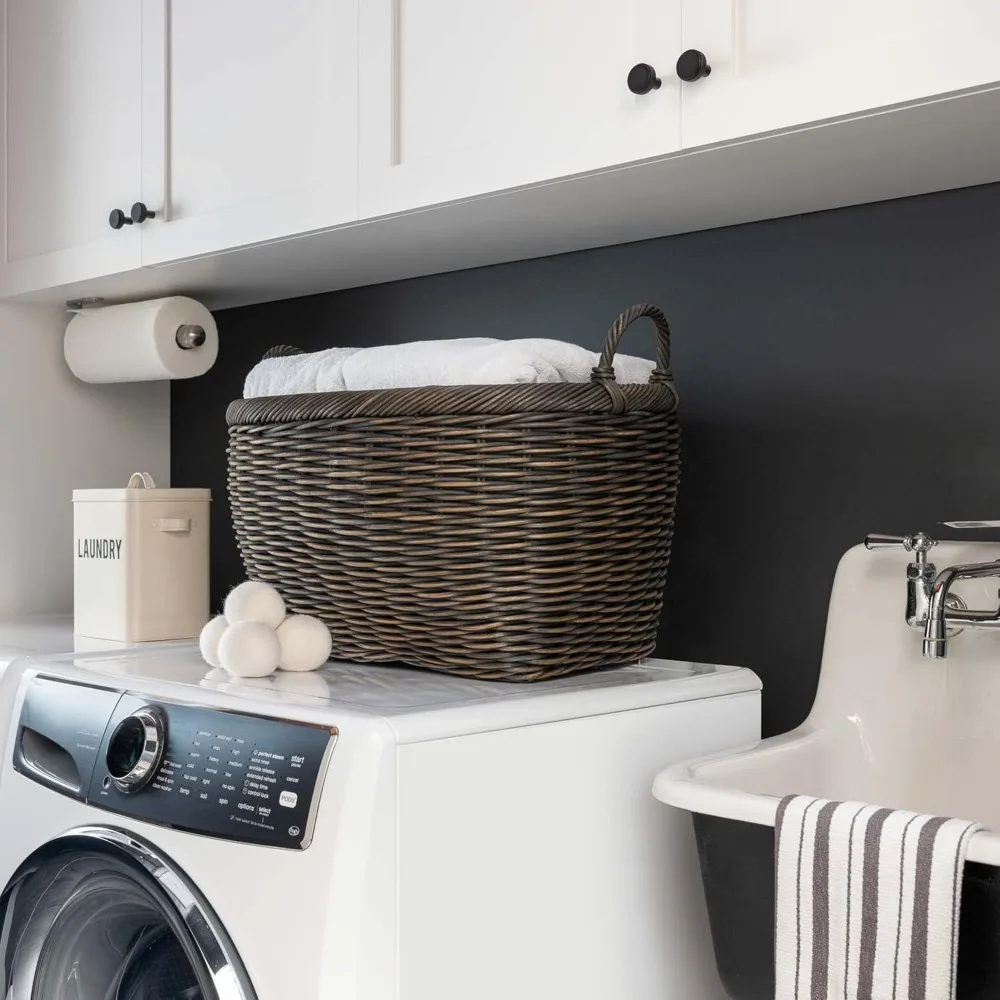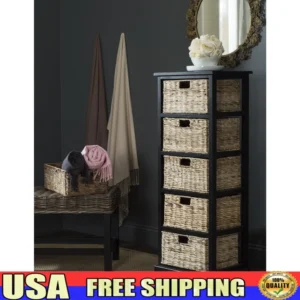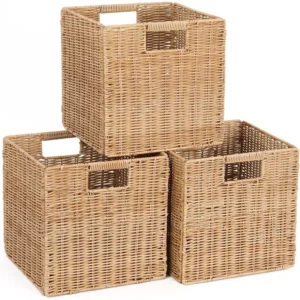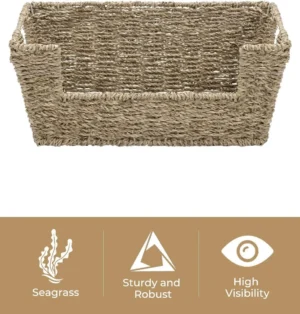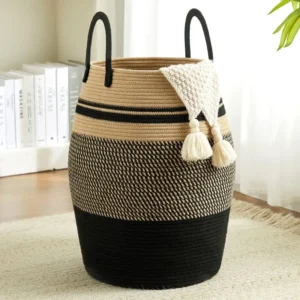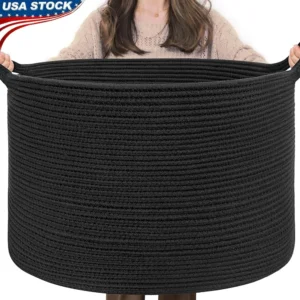What’s the Distinction Between Wicker and Woven Baskets?
When shopping for storage solutions or decorative items for your home, you’ve likely encountered both wicker and woven baskets. Despite being used interchangeably in conversation and even in product descriptions, these terms refer to different things.
The key difference is straightforward: Wicker is a specific technique used to create baskets and furniture, while “woven” describes the general process of interlacing materials to create an object.
Think of it this way – wicker is to weaving as baking is to cooking. All baking is cooking, but not all cooking is baking. Similarly, all wicker baskets are woven baskets, but not all woven baskets use the wicker technique.
This distinction matters because it helps you understand what you’re actually buying and the characteristics you can expect from different basket types. Throughout this article, we’ll explore the specific materials used in each, how to identify them visually, and which types might best suit your needs.
When comparing baskets, you might notice that a classic wicker basket features rigid materials woven around a frame in a distinctive pattern, while other woven baskets might use completely different techniques like coiling or plaiting, resulting in vastly different appearances and structural properties.
Understanding the real difference between basket styles can help you make more informed purchasing decisions for your home. For specific applications like laundry storage, the distinctions between wicker vs woven laundry baskets become particularly important for durability and function.
What Exactly is Wicker? The Technique Explained
Wicker isn’t a material – it’s a weaving technique. This is perhaps the most common misconception about wicker products and understanding this fundamental point clarifies much of the confusion surrounding wicker and woven terminology.
The word “wicker” comes from Scandinavian roots meaning “to bend” or “to fold,” which accurately describes the technique’s core action. This ancient weaving method dates back to approximately 3000 BC, making it one of humanity’s oldest crafting techniques.
The wicker technique involves:
- Weaving pliable materials around a rigid framework
- Creating a distinctive over-under pattern with vertical supports (stakes) and horizontal weaving elements (weavers)
- Typically using a frame structure that gives wicker items their characteristic sturdiness
- Finishing with bordered edges for strength and visual appeal
What makes wicker distinctive is its construction method. Unlike some other weaving techniques, true wicker work requires the weaver to create a skeleton structure first, around which the flexible materials are then meticulously woven. This results in the signature look that many associate with classic wicker furniture and baskets.
The repetitive, regular pattern creates the distinctive appearance most people immediately recognize as “wicker.” Historically, this technique has been used to create everything from simple baskets to elaborate furniture, demonstrating its versatility and durability.
Browse our collection of authentic wicker baskets to see examples of this traditional weaving technique in beautiful, functional forms.
Defining “Woven” in the Context of Basketry
“Woven” describes the fundamental process of interlacing materials to create a unified structure. It’s an umbrella term that encompasses numerous techniques, including wicker, but extends far beyond it.
At its most basic, weaving involves two elements:
- Warp elements – the foundation strands that remain relatively stationary
- Weft elements – the moving strands that pass over and under the warp
This simple concept gives rise to countless variations across cultures and applications. Woven basketry includes diverse techniques such as:
- Plaiting – where elements pass over and under each other at right angles
- Coiling – where materials spiral around a central core
- Twining – where active elements twist around passive elements
- Wicker – the specific technique using a rigid framework as described above
Each method produces distinctly different appearances and structural qualities in the finished basket. Some create tight, water-resistant containers, while others form more open, decorative pieces.
The breadth of woven basketry is remarkable – virtually any flexible material can be woven, from natural plant fibers to modern synthetics, recycled materials, and even metal wires. This versatility explains why woven containers remain relevant across millennia of human history.
To see the diversity of woven techniques in action, explore our collection of various woven basket techniques that showcase different weaving methods.
The Relationship Clarified: How Wicker Fits into the Woven Category
To put it simply: all wicker baskets are woven baskets, but not all woven baskets use the wicker technique.
This relationship can be understood through a simple hierarchy:
- Woven objects: Any items created by interlacing flexible materials
- Woven baskets: Containers made using any weaving technique
- Wicker baskets: A specific subset of woven baskets made using the wicker technique
Think of it like squares and rectangles – all squares are rectangles, but not all rectangles are squares. Similarly, wicker is just one branch on the much larger tree of woven crafts.
Understanding this distinction helps you properly identify and describe different basket types. When a product is labeled as “wicker,” it should specifically use that particular weaving technique. More general “woven” baskets might employ any number of other weaving methods.
This distinction isn’t merely academic – it affects what you can expect from different basket types in terms of appearance, strength, flexibility, and appropriate uses. For practical considerations when choosing between options, our guide on which is better: wicker or woven baskets offers helpful insights.
Materials Commonly Used in Wicker Basketry
The wicker technique can be applied to various pliable materials, each lending different characteristics to the finished product. Here’s a closer look at both natural and synthetic options commonly used:
Natural Materials:
Rattan: Derived from palm plants, rattan provides excellent strength and flexibility. Its solid core makes it ideal for furniture frames, while the outer skin (known as cane) creates smooth, durable surfaces.
Willow: Prized for its long, slender, and flexible branches, willow creates lightweight but sturdy wicker items. It’s particularly common in traditional European basketry.
Reed: Actually the inner core of rattan, reed is cost-effective and versatile. It absorbs stains well and is often used for basket weaving.
Bamboo: Offering exceptional strength-to-weight ratio, bamboo creates durable wicker pieces with a distinctive appearance due to its characteristic nodes.
Seagrass and Water Hyacinth: These grasses provide unique textures and natural color variations. Water hyacinth in particular has gained popularity as an eco-friendly option, as it’s harvested from invasive water plants.
Synthetic Materials:
Resin/PE Wicker: These weather-resistant synthetic fibers mimic the look of natural wicker but offer superior durability outdoors. They resist moisture, UV damage, and temperature fluctuations.
Vinyl and Other Synthetics: These materials create low-maintenance wicker items that can withstand heavy use. They’re often used in commercial settings or high-traffic household areas.
The material choice significantly impacts the basket’s appearance, durability, weight, and appropriate use environment. For example, natural materials generally create a warmer, more organic aesthetic but may require more care, while synthetics offer exceptional durability with less maintenance.

To explore the beautiful possibilities of one of the most popular wicker materials, browse our rattan baskets collection featuring items that showcase this versatile natural fiber.
The Diverse Materials Used in Other Woven Basket Styles
Beyond the materials typically associated with wicker, other woven basket techniques utilize an even wider array of materials, many of which wouldn’t be suitable for the wicker method. This diversity is part of what makes the broader category of woven baskets so rich and varied.
Traditional Natural Materials:
- Fine Grasses and Straws: Including sweetgrass, wheat straw, and various native grasses that create tight, fine weaves
- Pine Needles: Used primarily in coiled baskets, creating distinctive spiral patterns
- Palm Leaves: Produces sturdy, often colorful baskets in tropical regions
- Bark and Tree Fibers: Including cedar bark, birch, and other tree fibers that can be stripped and processed for weaving
Non-Traditional and Modern Materials:
- Textile Strips: Repurposed fabric, yarn, or rope creates soft, flexible baskets
- Paper Fibers: Including newspaper, magazines, or specialized paper cord
- Metal Wires: Creates decorative or industrial baskets with unique properties
- Recycled Materials: From plastic bags to repurposed irrigation tubing, modern basket makers increasingly work with recycled materials
These diverse materials allow for vastly different basket characteristics. For instance, tightly coiled pine needle baskets can be nearly waterproof, while open-weave palm leaf baskets allow for excellent airflow – properties that would be difficult to achieve with traditional wicker methods.
The cultural diversity in basket materials is remarkable – indigenous communities worldwide have masterfully used locally available materials to create baskets perfectly suited to specific functions, from winnowing grain to carrying water.
For a deeper understanding of how these materials relate to different weaving methods, our guide to the 4 main types of baskets and weaving provides a comprehensive overview.
Key Differences: Comparing Wicker and Other Woven Techniques
To clearly understand the distinctions between wicker and other weaving methods, let’s compare them across several important dimensions:
| Feature | Wicker Technique | Other Woven Techniques |
|---|---|---|
| Basic Structure | Uses framework with vertical stakes | May or may not use structural framework |
| Typical Materials | Requires rigid yet flexible materials | Can use almost any pliable material |
| Weaving Pattern | Primarily over-under pattern around fixed stakes | Includes coiling, plaiting, twining, and many variations |
| Typical Strength | Generally very sturdy due to framework | Varies widely depending on technique and material |
| Common Applications | Furniture, structured baskets, storage | Ranges from decorative pieces to functional containers |
| Visual Characteristics | Regular, repeating pattern with visible framework | Highly variable, from tight uniform patterns to artistic variations |
| Cultural Associations | Strong European and Asian traditions | Diverse techniques specific to regions worldwide |
The wicker technique creates items with inherent structure and stability, making it ideal for furniture and larger storage pieces. The frame-based construction provides excellent strength-to-weight ratio, which explains wicker’s popularity for chairs and other furniture.
In contrast, non-wicker woven techniques offer tremendous diversity. Coiled baskets, for example, can create watertight containers, while open-weave plaited baskets allow for ventilation of contents. Each technique brings its own advantages for specific uses.
These differences aren’t merely aesthetic – they determine the functionality and durability of the finished item. Understanding the benefits of woven and wicker laundry baskets can help you select the ideal storage solution for your specific needs.
Visual Identification: How to Spot Wicker Items
Identifying genuine wicker construction is relatively straightforward once you know what characteristics to look for. Here are the key visual markers:
Visible Framework: Authentic wicker items have a visible structural framework with thicker vertical elements (stakes) around which the horizontal elements (weavers) are woven.
Consistent Over-Under Pattern: The weaving follows a regular pattern where the weaver goes over one stake and under the next in an alternating fashion.
Rigid Construction: Wicker items maintain their shape without sagging, thanks to their sturdy framework.
Corner Construction: Look for reinforced corners where the framework creates defined edges and borders.
Surface Texture: True wicker has a characteristic texture created by the intersection of the weaving elements with the framework stakes.
The wicker pattern creates a distinctive “grid-like” appearance that’s immediately recognizable once you’re familiar with it. In furniture pieces, the framework is particularly evident in the arms, legs, and structural elements.

To see these identifying characteristics in practical items, our wicker laundry baskets collection provides excellent examples of classic wicker construction in everyday use.
Recognizing Various Types of Non-Wicker Woven Baskets
Beyond wicker, you’ll encounter numerous other basket weaving techniques, each with distinctive visual characteristics:
Coiled Baskets: Identified by their spiral construction, where a core material is wrapped and stitched in continuous rounds. These often have a smooth, sometimes sloped appearance with minimal visible texture.
Plaited Baskets: Created by weaving elements over and under each other at right angles, resulting in a checkerboard pattern. Unlike wicker, these don’t use a separate framework.
Twined Baskets: Recognized by pairs of horizontal elements twisting around vertical elements, creating distinctive diagonal patterns.
Random Weave Baskets: Feature materials woven in non-uniform patterns, creating artistic, sometimes asymmetrical designs.
Regional variations add further diversity – from the tight, geometric patterns of Native American baskets to the open, airy weaves of Mediterranean market baskets. Each cultural tradition has developed techniques perfectly suited to local materials and specific uses.
The density of the weave also varies significantly across different styles. Some baskets are tightly woven to hold small items or even liquids, while others feature open weaves that allow for visibility and airflow.
These diverse techniques create a rich visual language in basketry that goes far beyond the familiar wicker pattern. Exploring the versatile uses for wicker baskets in your home can help you appreciate how different weaving styles suit various functional needs.
Practical Applications: Common Uses for Wicker and Woven Baskets
The structural differences between wicker and other weaving techniques make them suited for different applications around the home:
Typical Wicker Applications:
- Furniture: The sturdy framework of wicker makes it ideal for chairs, tables, and larger furniture pieces that need to support weight.
- Storage Solutions: Rigid wicker baskets excel as storage containers for heavier items like blankets, toys, or firewood.
- Decorative Accents: The classic, structured appearance of wicker works well as decorative elements in traditional or coastal decor schemes.
- Laundry Hampers: The durability and airflow properties make wicker perfect for storing dirty clothing.
Common Uses for Other Woven Basket Types:
- Food-Related Uses: Many traditional basket techniques create containers specifically designed for gathering, washing, or storing food items.
- Specialized Functional Baskets: From fishing creels to egg baskets, specialized woven techniques create purpose-built tools.
- Wall Art and Decor: Especially coiled and artistic baskets that create beautiful textural elements for home decor.
- Gift Baskets and Packaging: Lightweight, decorative baskets perfect for presenting gifts or products.
The specific construction method directly impacts functionality. For example, the rigid structure of wicker makes it excellent for items that need to maintain their shape even when filled with heavy contents. Meanwhile, more flexible basket types might better accommodate irregularly shaped items or provide different aesthetic qualities.
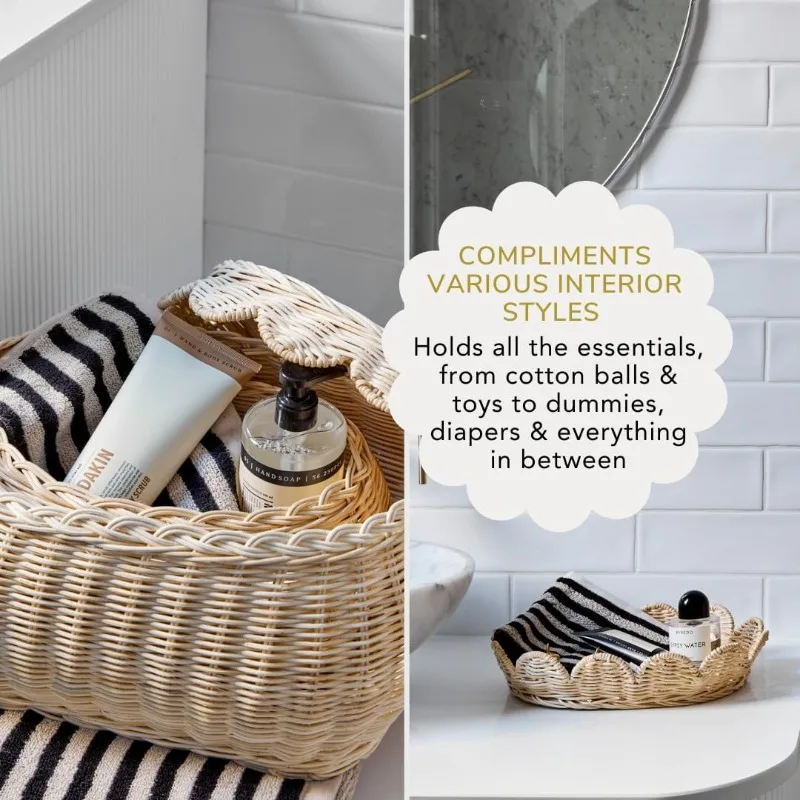
For practical storage solutions that leverage the sturdy construction of the wicker technique, our collection of wicker storage baskets offers options perfectly suited to organizing while enhancing your decor.
The Timeless Craft: A Brief History of Basketry Techniques
Basket weaving ranks among humanity’s oldest crafts, with archaeological evidence dating back more than 10,000 years. Long before pottery, baskets served as essential tools for gathering, storing, and transporting goods.
Wicker specifically has ancient roots, with examples found in Egyptian tombs from around 3000 BC. These early wicker items included not just baskets but also furniture and even chariots, demonstrating the technique’s versatility and strength.
Throughout history, basketry evolved differently across cultures based on available materials and local needs:
- In ancient Egypt, reed and papyrus created sturdy wicker goods for daily use and burial offerings
- Native American tribes developed diverse basketry techniques specific to regional materials, from tight coiled baskets in the Southwest to cedar bark weaving in the Pacific Northwest
- European traditions developed specialized forms like the willow basket-making traditions in England
- Asian cultures refined bamboo and rattan techniques for both practical and artistic applications
The Industrial Revolution initially threatened these traditional crafts, but the late 20th century saw a revival of interest in basketry as both functional craft and art form. Today, basket making bridges the gap between ancient tradition and contemporary design, with artisans around the world keeping these techniques alive.
This rich heritage is part of what makes woven baskets so special – each piece connects us to thousands of years of human creativity and problem-solving. For those interested in preserving these traditions, our guide on how to restore old woven baskets offers practical advice for maintaining these cultural artifacts.
Optimizing Basket Life: Care and Maintenance Tips
Proper care significantly extends the life of your wicker and woven baskets, preserving both their beauty and functionality. The specific care requirements depend on the materials used:
For Natural Wicker and Woven Baskets:
- Regular Dusting: Use a soft brush attachment on your vacuum or a dry cloth to remove dust from crevices.
- Spot Cleaning: Clean spills immediately with a slightly damp cloth, being careful not to saturate the material.
- Moisture Control: Keep natural fiber baskets in areas with moderate humidity – excessive dryness causes brittleness while too much moisture can lead to mold.
- Sun Protection: Limit direct sunlight exposure to prevent fading and material degradation.
- Occasional Deep Cleaning: For dirty baskets, use a mild soap solution with minimal water, followed by thorough drying.
For Synthetic Wicker and Woven Baskets:
- Regular Rinsing: Synthetic materials can typically be rinsed with water to remove dust and dirt.
- Soap Cleaning: Use mild detergent for deeper cleaning, with more thorough scrubbing allowed than with natural fibers.
- Sun Resistance: While more resistant to UV damage, even synthetic baskets benefit from limited direct sun exposure.
- Pressure Washing: Some outdoor synthetic wicker can withstand gentle pressure washing (check manufacturer recommendations).
Storage Recommendations for All Basket Types:
- Store in clean, dry areas away from extreme temperature fluctuations
- Avoid stacking heavy items on baskets that might deform their shape
- Consider stuffing larger baskets with acid-free paper to maintain their form during long-term storage
With proper care, quality baskets can last for decades or even generations. For more specific guidance, our detailed guide on how to clean wicker baskets offers step-by-step instructions for different materials and stain types.
Is Rattan the Same as Wicker? Common Misconceptions Clarified
One of the most persistent confusions in basket terminology is the relationship between rattan and wicker. Let’s set the record straight:
Is rattan the same as wicker?
No. Rattan is a material (a type of climbing palm), while wicker is a weaving technique. Rattan can be used to make wicker items, but not all wicker is made from rattan.
Why are these terms often confused?
Because rattan is one of the most common materials used in traditional wicker furniture, many people have come to associate the distinctive look of rattan wicker with all wicker products. This has led to the terms being incorrectly used interchangeably in everyday language and even in retail marketing.
What other misconceptions exist about these terms?
- “Wicker furniture” as a material category: People often say “wicker furniture” as though wicker were a specific material, rather than a construction technique.
- All-weather “wicker”: Modern outdoor furniture labeled as “wicker” is typically made from synthetic materials designed to mimic the wicker weaving style while offering weather resistance.
- Durability assumptions: There’s a misconception that all wicker is fragile, when in fact, well-made wicker items using quality materials can be extremely durable.
Understanding that rattan is just one of many possible materials for wicker construction helps clarify how these terms should be correctly used. For examples of how rattan specifically performs as a basket material, explore our storage baskets made specifically from rattan.
Choosing Between Wicker and Other Woven Baskets: A Buyer’s Guide
When selecting baskets for your home, consider these key factors to determine whether traditional wicker or another weaving technique will best meet your needs:
Intended Use and Functionality:
* Choose structured wicker baskets for heavier items requiring support
* Select flexible woven baskets for irregularly shaped items
* Consider specialized basket types for specific functions (like gathering baskets with handles)
Indoor vs. Outdoor Placement:
* For outdoor use, select synthetic wicker specifically designed for weather resistance
* For humid indoor areas like bathrooms, choose baskets with mold-resistant properties
* Consider natural materials for low-humidity indoor environments
Aesthetic Considerations:
* Traditional wicker offers a classic, structured appearance that suits many decor styles
* Artistic coiled or random weave baskets make stronger decorative statements
* Consider how the basket’s color, texture, and pattern complement your existing decor
Durability Requirements:
* High-traffic areas benefit from sturdier wicker construction
* Children’s rooms might need more flexible, lightweight basket options
* Consider basket edge finishing – reinforced edges last longer in heavy use
Budget Considerations:
* Hand-crafted specialty baskets typically command higher prices
* Machine-made wicker offers good value for everyday storage
* Synthetic materials often provide greater durability at moderate price points
Black Wicker Baskets, Rattan Storage Baskets, Tall Wicker Baskets, Wicker Shelf Baskets, Woven Storage Baskets
5-Tier Distressed Black Wood Frame Storage Tower with Removable Wicker Baskets for Home Organization$715.80 Select options This product has multiple variants. The options may be chosen on the product pageWicker Laundry Baskets, Woven Laundry Baskets, Woven Storage Baskets
$392.02 Select options This product has multiple variants. The options may be chosen on the product pageRattan Shelf Baskets, Rattan Storage Baskets, Small Wicker Baskets, Square Wicker Baskets
Square Plastic Wicker Storage Baskets Set of 3 with Collapsible Design for Cube Storage Organization$185.47 Select options This product has multiple variants. The options may be chosen on the product pageWicker Baskets with Handles, Wicker Storage Baskets, Woven Storage Baskets
$137.92 Select options This product has multiple variants. The options may be chosen on the product pageLarge Wicker Laundry Baskets, Tall Wicker Baskets, Woven Laundry Hampers, Woven Storage Baskets
$130.54 Select options This product has multiple variants. The options may be chosen on the product pageWicker Blanket Baskets, Woven Laundry Baskets
$89.60 Select options This product has multiple variants. The options may be chosen on the product page
When evaluating quality in either category, examine the evenness of the weave, stability of the construction, and finishing of the edges and handles. Quality baskets should feel solid, with no loose ends or wobbly sections.
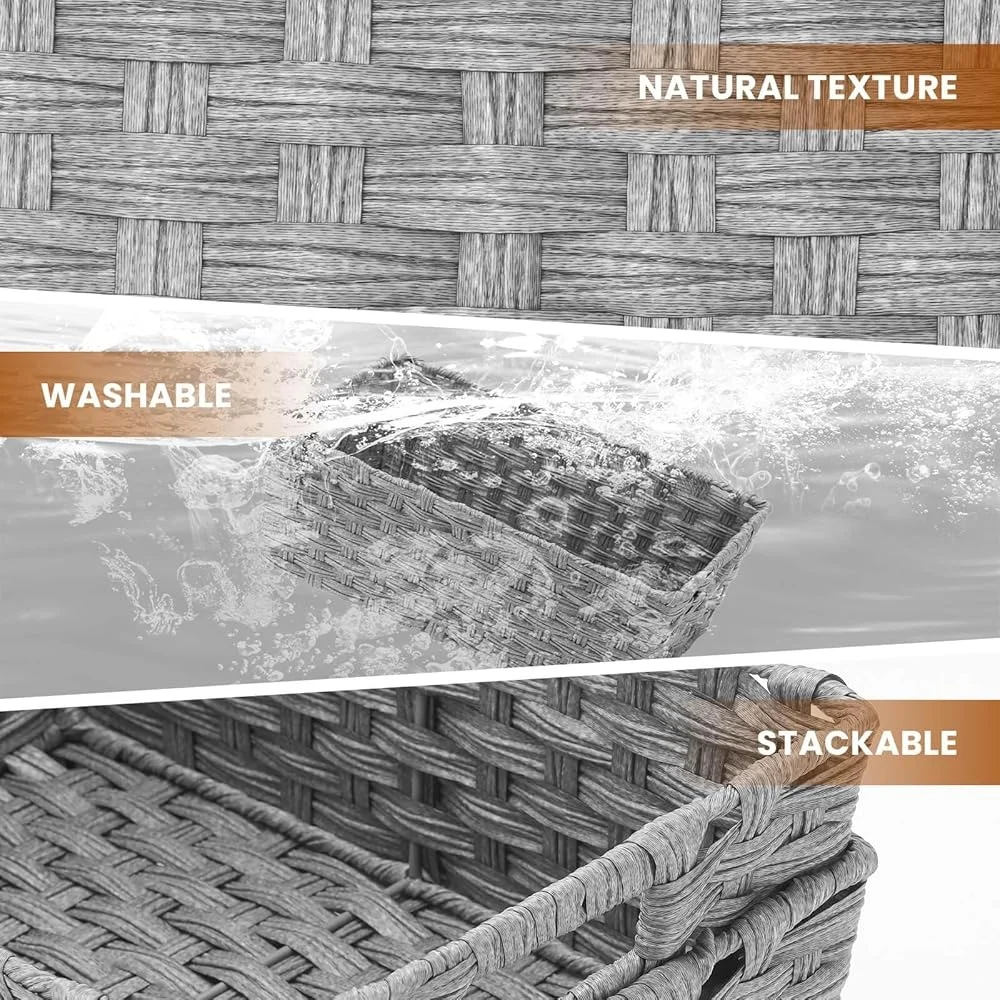
For more detailed purchasing guidance, our comprehensive buying guide for wicker and woven baskets can help you make an informed decision based on your specific needs.
Frequently Asked Questions About Wicker and Woven Baskets
Can natural wicker be used outdoors?
Natural wicker materials like rattan and willow aren’t ideal for continuous outdoor exposure. They’ll deteriorate when subjected to moisture and UV rays. For outdoor use, choose synthetic wicker materials specifically designed for weather resistance.
How can I tell if a basket is handmade?
Handmade baskets typically show slight variations in the weave pattern and may have small inconsistencies that add character. Machine-made baskets have perfectly uniform patterns. Also look for the complexity of the weaving pattern – very intricate designs are often indicators of handcrafting.
Are synthetic wicker products environmentally friendly?
Most synthetic wicker is made from petroleum-based materials like polyethylene, which isn’t biodegradable. However, high-quality synthetic wicker products can last decades, reducing the need for replacement. Some manufacturers now offer recycled plastic wicker options as a more eco-friendly alternative.
What’s the most durable material for wicker products?
For indoor use, genuine rattan creates extremely durable wicker pieces that can last generations with proper care. For outdoor use, high-density polyethylene (HDPE) synthetic wicker offers the best combination of weather resistance and longevity.
How do I restore a damaged wicker basket?
Minor breaks in natural wicker can often be repaired by soaking the broken area to make it pliable, then reshaping and securing it until dry. More significant damage might require replacing individual weaving elements. Synthetic wicker typically needs damaged sections cut out and replaced.
Can I paint or stain my wicker items?
Yes, natural wicker accepts both paint and stain well. For best results, clean the basket thoroughly, apply a primer if painting, and use multiple light coats rather than fewer heavy ones. Spray applications work particularly well for reaching all the crevices in wicker items.
For answers to additional questions about selecting and caring for these versatile storage solutions, our comprehensive resource for all wicker and woven basket questions provides detailed information.
Exploring Premium Wicker and Woven Storage Solutions for Your Home
High-quality wicker and woven baskets from Tidy Treasure offer more than just practical storage – they bring warmth, texture, and natural beauty to your home while helping organize your space beautifully.
The dual benefit of these baskets makes them particularly valuable home investments:
- They provide practical, versatile storage for everything from blankets to toys to pantry items
- They simultaneously serve as decorative elements that enhance your interior design
- Their natural materials and textures add warmth to modern spaces
- Their timeless appeal means they won’t quickly go out of style like plastic organizers
Creating cohesive home styling becomes easier with carefully selected baskets that complement your existing decor. Whether you prefer the classic structure of traditional wicker or the artistic appeal of other woven techniques, quality baskets elevate both the function and appearance of your spaces.
Unlike disposable plastic storage, premium wicker and woven baskets often become more beautiful with age, developing character while continuing to serve their practical purpose. This makes them both environmentally and economically sound choices for the conscientious homeowner.
For creative ways to incorporate these beautiful storage solutions into your decor scheme, our guide to decorating with rattan storage baskets offers inspiration and practical styling tips to enhance your home.

